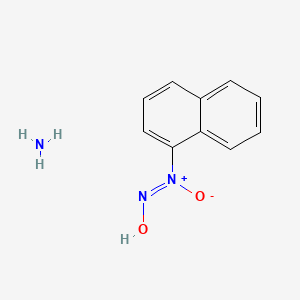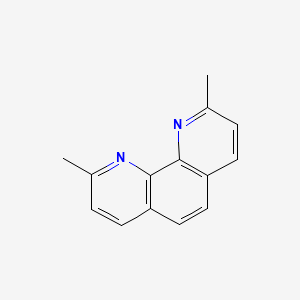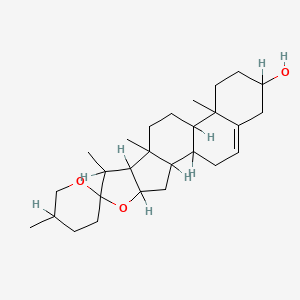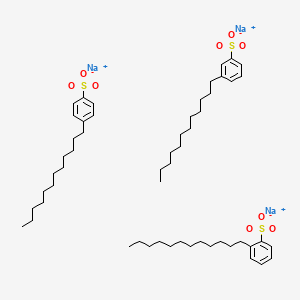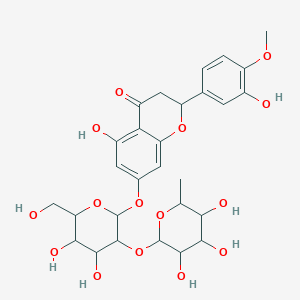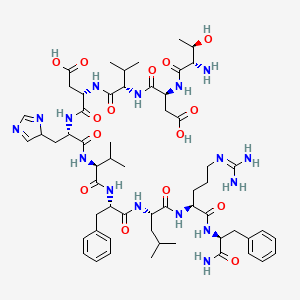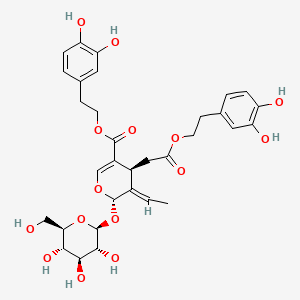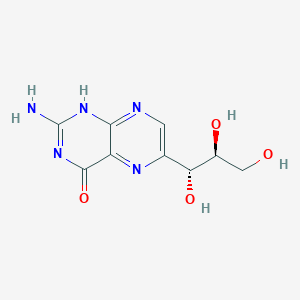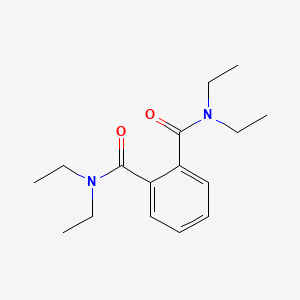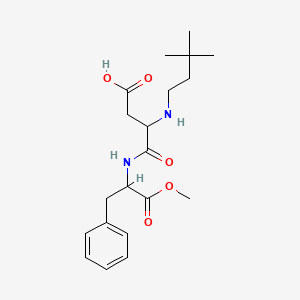
Procarbazine
Descripción general
Descripción
La procarbazina es un medicamento de quimioterapia que se usa principalmente para el tratamiento del linfoma de Hodgkin y ciertos tipos de cáncer cerebral, como el glioblastoma multiforme . Pertenece a la clase de agentes alquilantes, que funcionan agregando grupos alquilo a muchos grupos electronegativos en condiciones presentes en las células . La procarbazina fue aprobada para uso médico en los Estados Unidos en 1969 y está incluida en la Lista de Medicamentos Esenciales de la Organización Mundial de la Salud .
Métodos De Preparación
Rutas sintéticas y condiciones de reacción: La síntesis de procarbazina implica varios pasos que comienzan con el p-toluil aldehído. El proceso incluye la adición de ácido cianúrico dibromo e isopropilamina para obtener toluil isopropilamina. Este intermedio se disuelve luego en un reactivo orgánico, seguido de la adición de N-bromo-succinimida y un iniciador. La mezcla se calienta a reflujo y se elimina el solvente. Se añaden acetonitrilo y un agente acelerador hidrolítico, y la mezcla se calienta a reflujo para formar formoxil benzoil isopropil amina. Finalmente, la formoxil benzoil isopropil amina se hace reaccionar con sulfato de metilhidrazinio y trietilamina, seguida de la adición de cianoborohidruro de sodio, lo que da como resultado la formación de procarbazina .
Métodos de producción industrial: La producción industrial de procarbazina sigue rutas sintéticas similares pero se optimiza para obtener mayores rendimientos y eficiencia. El proceso evita el uso de oxidantes fuertes y ácidos fuertes, lo que lo hace más ecológico. La tasa de recuperación total del método industrial es aproximadamente del 52.9% .
Análisis De Reacciones Químicas
Tipos de reacciones: La procarbazina experimenta diversas reacciones químicas, que incluyen oxidación, reducción y sustitución. Una reacción notable es su autooxidación para formar un derivado azoico, que luego se isomeriza a una hidrazona. Esta hidrazona se somete a hidrólisis para producir un derivado de benzaldehído y metilhidrazina .
Reactivos y condiciones comunes: Los reactivos comunes utilizados en las reacciones que involucran procarbazina incluyen N-bromo-succinimida, acetonitrilo, agentes aceleradores hidrolíticos, sulfato de metilhidrazinio y cianoborohidruro de sodio . Las condiciones de reacción generalmente involucran calentamiento a reflujo y el uso de solventes orgánicos.
Productos principales: Los productos principales formados a partir de las reacciones de procarbazina incluyen derivados de benzaldehído y metilhidrazina .
Aplicaciones Científicas De Investigación
La procarbazina tiene una amplia gama de aplicaciones de investigación científica, particularmente en los campos de la química, la biología, la medicina y la industria. En medicina, se utiliza como parte de los regímenes de quimioterapia combinada para tratar el linfoma de Hodgkin y los cánceres cerebrales . En química, la procarbazina se estudia por sus propiedades alquilantes únicas y sus interacciones con diversas nanoestructuras para sistemas de administración de fármacos . En biología, se utiliza para estudiar los efectos de los agentes alquilantes en los procesos celulares y la síntesis de ADN . Las aplicaciones industriales incluyen su uso en la síntesis de otros compuestos farmacéuticos y su papel en el desarrollo de métodos de producción ecológicos .
Mecanismo De Acción
El mecanismo de acción preciso de la procarbazina no se comprende completamente. se sabe que inhibe la síntesis de proteínas, ARN y ADN al interferir con la transmetilación de los grupos metilo de la metionina en el ARN de transferencia . La procarbazina también funciona como un agente alquilante, metilando la guanina en la posición O-6, lo que lleva a la ruptura del ADN e inhibición de la síntesis de ARN y proteínas .
Comparación Con Compuestos Similares
Compuestos similares: Los compuestos similares a la procarbazina incluyen dacarbazina, bleomicina y nivolumab . Estos compuestos también se utilizan en el tratamiento de diversos cánceres y tienen mecanismos de acción similares como agentes alquilantes o antineoplásicos.
Singularidad: La procarbazina es única en su capacidad para ser utilizada en combinación con otros agentes quimioterapéuticos, como la clormetina, la vincristina y la prednisona, para el tratamiento del linfoma de Hodgkin . También se distingue por su interacción con las nanoestructuras para sistemas de administración de fármacos, lo que aumenta su eficacia en la focalización de las células cancerosas .
Propiedades
IUPAC Name |
4-[(2-methylhydrazinyl)methyl]-N-propan-2-ylbenzamide | |
|---|---|---|
| Source | PubChem | |
| URL | https://pubchem.ncbi.nlm.nih.gov | |
| Description | Data deposited in or computed by PubChem | |
InChI |
InChI=1S/C12H19N3O/c1-9(2)15-12(16)11-6-4-10(5-7-11)8-14-13-3/h4-7,9,13-14H,8H2,1-3H3,(H,15,16) | |
| Source | PubChem | |
| URL | https://pubchem.ncbi.nlm.nih.gov | |
| Description | Data deposited in or computed by PubChem | |
InChI Key |
CPTBDICYNRMXFX-UHFFFAOYSA-N | |
| Source | PubChem | |
| URL | https://pubchem.ncbi.nlm.nih.gov | |
| Description | Data deposited in or computed by PubChem | |
Canonical SMILES |
CC(C)NC(=O)C1=CC=C(C=C1)CNNC | |
| Source | PubChem | |
| URL | https://pubchem.ncbi.nlm.nih.gov | |
| Description | Data deposited in or computed by PubChem | |
Molecular Formula |
C12H19N3O | |
| Source | PubChem | |
| URL | https://pubchem.ncbi.nlm.nih.gov | |
| Description | Data deposited in or computed by PubChem | |
Related CAS |
366-70-1 (mono-hydrochloride) | |
| Record name | Procarbazine [INN:BAN] | |
| Source | ChemIDplus | |
| URL | https://pubchem.ncbi.nlm.nih.gov/substance/?source=chemidplus&sourceid=0000671169 | |
| Description | ChemIDplus is a free, web search system that provides access to the structure and nomenclature authority files used for the identification of chemical substances cited in National Library of Medicine (NLM) databases, including the TOXNET system. | |
DSSTOX Substance ID |
DTXSID4021189 | |
| Record name | Procarbazine | |
| Source | EPA DSSTox | |
| URL | https://comptox.epa.gov/dashboard/DTXSID4021189 | |
| Description | DSSTox provides a high quality public chemistry resource for supporting improved predictive toxicology. | |
Molecular Weight |
221.30 g/mol | |
| Source | PubChem | |
| URL | https://pubchem.ncbi.nlm.nih.gov | |
| Description | Data deposited in or computed by PubChem | |
Physical Description |
Solid | |
| Record name | Procarbazine | |
| Source | Human Metabolome Database (HMDB) | |
| URL | http://www.hmdb.ca/metabolites/HMDB0015299 | |
| Description | The Human Metabolome Database (HMDB) is a freely available electronic database containing detailed information about small molecule metabolites found in the human body. | |
| Explanation | HMDB is offered to the public as a freely available resource. Use and re-distribution of the data, in whole or in part, for commercial purposes requires explicit permission of the authors and explicit acknowledgment of the source material (HMDB) and the original publication (see the HMDB citing page). We ask that users who download significant portions of the database cite the HMDB paper in any resulting publications. | |
Solubility |
In water, 1,400 mg/L @ 25 °C /Estimated/, 2.28e-01 g/L | |
| Record name | Procarbazine | |
| Source | DrugBank | |
| URL | https://www.drugbank.ca/drugs/DB01168 | |
| Description | The DrugBank database is a unique bioinformatics and cheminformatics resource that combines detailed drug (i.e. chemical, pharmacological and pharmaceutical) data with comprehensive drug target (i.e. sequence, structure, and pathway) information. | |
| Explanation | Creative Common's Attribution-NonCommercial 4.0 International License (http://creativecommons.org/licenses/by-nc/4.0/legalcode) | |
| Record name | PROCARBAZINE | |
| Source | Hazardous Substances Data Bank (HSDB) | |
| URL | https://pubchem.ncbi.nlm.nih.gov/source/hsdb/3250 | |
| Description | The Hazardous Substances Data Bank (HSDB) is a toxicology database that focuses on the toxicology of potentially hazardous chemicals. It provides information on human exposure, industrial hygiene, emergency handling procedures, environmental fate, regulatory requirements, nanomaterials, and related areas. The information in HSDB has been assessed by a Scientific Review Panel. | |
| Record name | Procarbazine | |
| Source | Human Metabolome Database (HMDB) | |
| URL | http://www.hmdb.ca/metabolites/HMDB0015299 | |
| Description | The Human Metabolome Database (HMDB) is a freely available electronic database containing detailed information about small molecule metabolites found in the human body. | |
| Explanation | HMDB is offered to the public as a freely available resource. Use and re-distribution of the data, in whole or in part, for commercial purposes requires explicit permission of the authors and explicit acknowledgment of the source material (HMDB) and the original publication (see the HMDB citing page). We ask that users who download significant portions of the database cite the HMDB paper in any resulting publications. | |
Vapor Pressure |
8.4X10-7 mm Hg @ 25 °C /Estimated/ | |
| Record name | PROCARBAZINE | |
| Source | Hazardous Substances Data Bank (HSDB) | |
| URL | https://pubchem.ncbi.nlm.nih.gov/source/hsdb/3250 | |
| Description | The Hazardous Substances Data Bank (HSDB) is a toxicology database that focuses on the toxicology of potentially hazardous chemicals. It provides information on human exposure, industrial hygiene, emergency handling procedures, environmental fate, regulatory requirements, nanomaterials, and related areas. The information in HSDB has been assessed by a Scientific Review Panel. | |
Mechanism of Action |
The precise mode of cytotoxic action of procarbazine has not been clearly defined. There is evidence that the drug may act by inhibition of protein, RNA and DNA synthesis. Studies have suggested that procarbazine may inhibit transmethylation of methyl groups of methionine into t-RNA. The absence of functional t-RNA could cause the cessation of protein synthesis and consequently DNA and RNA synthesis. In addition, procarbazine may directly damage DNA. Hydrogen peroxide, formed during the auto-oxidation of the drug, may attack protein sulfhydryl groups contained in residual protein which is tightly bound to DNA., Procarbazine is an alkylating agent. The exact mechanism of antineoplastic action is unknown but is thought to resemble that of the alkylating agents; procarbazine is cell cycle-specific for the S phase of cell division. Procarbazine is thought to inhibit DNA, RNA, and protein synthesis., O-6-Methylguanine was measured in blood leukocyte DNA of seven patients with Hodgkin's or non-Hodgkin's lymphoma during therapeutic exposure to procarbazine involving three daily p.o. doses (50 mg each) for 10 days (corresponding to 2.1 mg/kg/day for a 70-kg human). Adduct accumulation was observed in all seven cases, reaching levels up to 0.28 fmol/microgram of DNA (0.45 umol/mol of guanine). In one individual, maximal levels of adduct were reached after 7 days of exposure, followed by a steady decline, whereas in all other individuals continuous accumulation was observed throughout the exposure period. In four individuals for which data were available for day 11 (12 to 16 hr after the final intake of procarbazine), decreased amounts of O-6-methylguanine were observed relative to the last previous measurements. The accumulation of O-6-methylguanine was linearly correlated with the cumulative dose of procarbazine, with a slope of 0.011 fmol of O-6-methylguanine/microgram of DNA per mg/kg of body weight or 2.68x10-4 fmol of O-6-methylguanine DNA per mg/sq m. Two hr after the administration of single p.o. doses of l to 10 mg/kg of procarbazine to rats, O-6-methylguanine formation in leukocyte DNA was just under half that in liver DNA and showed a linear relationship with dose with a slope of 0.017 fmol/microgram of DNA per mg/kg of body weight or 5.67x10-4 fmol of O-6-methylguanine/microgram of DNA per mg/sq m. A negative correlation between the rate of accumulation of O-6-methylguanine in different individuals and lymphocyte O-6-alkylguanine-DNA alkyltransferase was observed, demonstrating a probable protective effect of O-6-alkylguanine-DNA alkyltransferase against the accumulation of O-6-methylguanine during exposure to methylating agents. This observation supports the suggestion of a possible role of procarbazine-induced O-6-methylguanine in the pathogenesis of acute nonlymphocytic leukemia appearing after treatment with chemotherapeutic protocols which include procarbazine, based on the finding of low lymphocyte O-6-alkylguanine-DNA alkyltransferase levels in patients with such therapy-related neoplastic disease. Lymphocyte O-6-alkylguanine-DNA alkyltransferase levels were mainly in the range of 5 to 10 fmol/micrograms of DNA and showed no consistent variation during procarbazine exposure., Procarbazine causes weak inhibition of monoamine oxidase (MAO). MAO inhibitors prevent the inactivation of tyramine by hepatic and gastrointestinal monoamine oxidase. Tyramine in the bloodstream releases norepinephrine from the sympathetic nerve terminals and produces a sudden increase in blood pressure. | |
| Record name | Procarbazine | |
| Source | DrugBank | |
| URL | https://www.drugbank.ca/drugs/DB01168 | |
| Description | The DrugBank database is a unique bioinformatics and cheminformatics resource that combines detailed drug (i.e. chemical, pharmacological and pharmaceutical) data with comprehensive drug target (i.e. sequence, structure, and pathway) information. | |
| Explanation | Creative Common's Attribution-NonCommercial 4.0 International License (http://creativecommons.org/licenses/by-nc/4.0/legalcode) | |
| Record name | PROCARBAZINE | |
| Source | Hazardous Substances Data Bank (HSDB) | |
| URL | https://pubchem.ncbi.nlm.nih.gov/source/hsdb/3250 | |
| Description | The Hazardous Substances Data Bank (HSDB) is a toxicology database that focuses on the toxicology of potentially hazardous chemicals. It provides information on human exposure, industrial hygiene, emergency handling procedures, environmental fate, regulatory requirements, nanomaterials, and related areas. The information in HSDB has been assessed by a Scientific Review Panel. | |
CAS No. |
671-16-9, 366-70-1 | |
| Record name | Procarbazine | |
| Source | CAS Common Chemistry | |
| URL | https://commonchemistry.cas.org/detail?cas_rn=671-16-9 | |
| Description | CAS Common Chemistry is an open community resource for accessing chemical information. Nearly 500,000 chemical substances from CAS REGISTRY cover areas of community interest, including common and frequently regulated chemicals, and those relevant to high school and undergraduate chemistry classes. This chemical information, curated by our expert scientists, is provided in alignment with our mission as a division of the American Chemical Society. | |
| Explanation | The data from CAS Common Chemistry is provided under a CC-BY-NC 4.0 license, unless otherwise stated. | |
| Record name | Procarbazine [INN:BAN] | |
| Source | ChemIDplus | |
| URL | https://pubchem.ncbi.nlm.nih.gov/substance/?source=chemidplus&sourceid=0000671169 | |
| Description | ChemIDplus is a free, web search system that provides access to the structure and nomenclature authority files used for the identification of chemical substances cited in National Library of Medicine (NLM) databases, including the TOXNET system. | |
| Record name | Procarbazine | |
| Source | DrugBank | |
| URL | https://www.drugbank.ca/drugs/DB01168 | |
| Description | The DrugBank database is a unique bioinformatics and cheminformatics resource that combines detailed drug (i.e. chemical, pharmacological and pharmaceutical) data with comprehensive drug target (i.e. sequence, structure, and pathway) information. | |
| Explanation | Creative Common's Attribution-NonCommercial 4.0 International License (http://creativecommons.org/licenses/by-nc/4.0/legalcode) | |
| Record name | Procarbazine hydrochloride | |
| Source | DTP/NCI | |
| URL | https://dtp.cancer.gov/dtpstandard/servlet/dwindex?searchtype=NSC&outputformat=html&searchlist=759626 | |
| Description | The NCI Development Therapeutics Program (DTP) provides services and resources to the academic and private-sector research communities worldwide to facilitate the discovery and development of new cancer therapeutic agents. | |
| Explanation | Unless otherwise indicated, all text within NCI products is free of copyright and may be reused without our permission. Credit the National Cancer Institute as the source. | |
| Record name | Procarbazine | |
| Source | EPA DSSTox | |
| URL | https://comptox.epa.gov/dashboard/DTXSID4021189 | |
| Description | DSSTox provides a high quality public chemistry resource for supporting improved predictive toxicology. | |
| Record name | Procarbazine | |
| Source | European Chemicals Agency (ECHA) | |
| URL | https://echa.europa.eu/substance-information/-/substanceinfo/100.010.531 | |
| Description | The European Chemicals Agency (ECHA) is an agency of the European Union which is the driving force among regulatory authorities in implementing the EU's groundbreaking chemicals legislation for the benefit of human health and the environment as well as for innovation and competitiveness. | |
| Explanation | Use of the information, documents and data from the ECHA website is subject to the terms and conditions of this Legal Notice, and subject to other binding limitations provided for under applicable law, the information, documents and data made available on the ECHA website may be reproduced, distributed and/or used, totally or in part, for non-commercial purposes provided that ECHA is acknowledged as the source: "Source: European Chemicals Agency, http://echa.europa.eu/". Such acknowledgement must be included in each copy of the material. ECHA permits and encourages organisations and individuals to create links to the ECHA website under the following cumulative conditions: Links can only be made to webpages that provide a link to the Legal Notice page. | |
| Record name | PROCARBAZINE | |
| Source | FDA Global Substance Registration System (GSRS) | |
| URL | https://gsrs.ncats.nih.gov/ginas/app/beta/substances/35S93Y190K | |
| Description | The FDA Global Substance Registration System (GSRS) enables the efficient and accurate exchange of information on what substances are in regulated products. Instead of relying on names, which vary across regulatory domains, countries, and regions, the GSRS knowledge base makes it possible for substances to be defined by standardized, scientific descriptions. | |
| Explanation | Unless otherwise noted, the contents of the FDA website (www.fda.gov), both text and graphics, are not copyrighted. They are in the public domain and may be republished, reprinted and otherwise used freely by anyone without the need to obtain permission from FDA. Credit to the U.S. Food and Drug Administration as the source is appreciated but not required. | |
| Record name | PROCARBAZINE | |
| Source | Hazardous Substances Data Bank (HSDB) | |
| URL | https://pubchem.ncbi.nlm.nih.gov/source/hsdb/3250 | |
| Description | The Hazardous Substances Data Bank (HSDB) is a toxicology database that focuses on the toxicology of potentially hazardous chemicals. It provides information on human exposure, industrial hygiene, emergency handling procedures, environmental fate, regulatory requirements, nanomaterials, and related areas. The information in HSDB has been assessed by a Scientific Review Panel. | |
| Record name | Procarbazine | |
| Source | Human Metabolome Database (HMDB) | |
| URL | http://www.hmdb.ca/metabolites/HMDB0015299 | |
| Description | The Human Metabolome Database (HMDB) is a freely available electronic database containing detailed information about small molecule metabolites found in the human body. | |
| Explanation | HMDB is offered to the public as a freely available resource. Use and re-distribution of the data, in whole or in part, for commercial purposes requires explicit permission of the authors and explicit acknowledgment of the source material (HMDB) and the original publication (see the HMDB citing page). We ask that users who download significant portions of the database cite the HMDB paper in any resulting publications. | |
Melting Point |
223 °C | |
| Record name | Procarbazine | |
| Source | DrugBank | |
| URL | https://www.drugbank.ca/drugs/DB01168 | |
| Description | The DrugBank database is a unique bioinformatics and cheminformatics resource that combines detailed drug (i.e. chemical, pharmacological and pharmaceutical) data with comprehensive drug target (i.e. sequence, structure, and pathway) information. | |
| Explanation | Creative Common's Attribution-NonCommercial 4.0 International License (http://creativecommons.org/licenses/by-nc/4.0/legalcode) | |
| Record name | Procarbazine | |
| Source | Human Metabolome Database (HMDB) | |
| URL | http://www.hmdb.ca/metabolites/HMDB0015299 | |
| Description | The Human Metabolome Database (HMDB) is a freely available electronic database containing detailed information about small molecule metabolites found in the human body. | |
| Explanation | HMDB is offered to the public as a freely available resource. Use and re-distribution of the data, in whole or in part, for commercial purposes requires explicit permission of the authors and explicit acknowledgment of the source material (HMDB) and the original publication (see the HMDB citing page). We ask that users who download significant portions of the database cite the HMDB paper in any resulting publications. | |
Retrosynthesis Analysis
AI-Powered Synthesis Planning: Our tool employs the Template_relevance Pistachio, Template_relevance Bkms_metabolic, Template_relevance Pistachio_ringbreaker, Template_relevance Reaxys, Template_relevance Reaxys_biocatalysis model, leveraging a vast database of chemical reactions to predict feasible synthetic routes.
One-Step Synthesis Focus: Specifically designed for one-step synthesis, it provides concise and direct routes for your target compounds, streamlining the synthesis process.
Accurate Predictions: Utilizing the extensive PISTACHIO, BKMS_METABOLIC, PISTACHIO_RINGBREAKER, REAXYS, REAXYS_BIOCATALYSIS database, our tool offers high-accuracy predictions, reflecting the latest in chemical research and data.
Strategy Settings
| Precursor scoring | Relevance Heuristic |
|---|---|
| Min. plausibility | 0.01 |
| Model | Template_relevance |
| Template Set | Pistachio/Bkms_metabolic/Pistachio_ringbreaker/Reaxys/Reaxys_biocatalysis |
| Top-N result to add to graph | 6 |
Feasible Synthetic Routes
Descargo de responsabilidad e información sobre productos de investigación in vitro
Tenga en cuenta que todos los artículos e información de productos presentados en BenchChem están destinados únicamente con fines informativos. Los productos disponibles para la compra en BenchChem están diseñados específicamente para estudios in vitro, que se realizan fuera de organismos vivos. Los estudios in vitro, derivados del término latino "in vidrio", involucran experimentos realizados en entornos de laboratorio controlados utilizando células o tejidos. Es importante tener en cuenta que estos productos no se clasifican como medicamentos y no han recibido la aprobación de la FDA para la prevención, tratamiento o cura de ninguna condición médica, dolencia o enfermedad. Debemos enfatizar que cualquier forma de introducción corporal de estos productos en humanos o animales está estrictamente prohibida por ley. Es esencial adherirse a estas pautas para garantizar el cumplimiento de los estándares legales y éticos en la investigación y experimentación.




